"Accosted" in the Amazon
- Devon Graham-Project Amazonas
- Dec 13, 2022
- 7 min read
Updated: Dec 13, 2022
Yep, I got mugged in the Amazon. Accosted by a plant, no less. "Costus" sounds like the name of an ancient Greek god. That's not too far off, actually. It is the Sanskrit name for the plant known to science as Costus speciosus, an herbaceous plant native of the Indian subcontinent, and whose aromatic rhizomes were used medicinally for treating skin diseases, parasitic infections, leprosy and more. The medicinal properties of these plants have been known to people for a very long time, with the first known description occurring in the Ayurveda, a medical treatise written in India about 400 CE.
Dimerocostus appendiculatus (L), one of the larger species reaching up to 5 meters in height; Costus sinningiiflorus (C) and C. arabicus (R). The wide lips on the flowers are characteristic of bee-pollinated species.
Plants in the family Costaceae (including Costus and other genera) are widespread throughout tropical America, and from Africa and across Asia to Australia and Melanesia. Commonly known as spiral gingers due their unique growth form and aromatic rhizomes, these are a group of plants that are very easy to recognize, at least to plant family. The stems are unbranched in most species, and grow in a spiral, with each additional leaf offset so as to not shade the older leaves below it.

Costus sinningiiflorus (previously known as C. guaniensis) showing the spiral growth form of the stems and non-overlapping leaves.
Costaceae are a conspicuous herbaceous component of forest understory at our field stations in the Peruvian Amazon. Some species also do very well in high light environments along river edges and in human-disturbed environments including pastures, roadsides and agricultural areas. Just because they are non-woody, doesn’t mean that they are all small, though! We’ve found some plants as tall as 5 meters (>15’) at the Madre Selva Biological Station. Species of Costaceae have two different flowering modes and two pollination modes. In some species, flowers are produced on the ends of the vegetative stalks, with the flowers topping the spiral of leaves. In other species, flowers are produced on separate non-leaf bearing stalks, although some flower bracts may be somewhat leaf-like. The two pollination modes – broad, flat-lipped bee-pollinated vs. tubular hummingbird-pollinated flowers, have resulted in very different flower appearances between species.
Costus erythrocoryne (L), with flowers on a separate basal stalk; C. spiralis (C), with flowers at the top of a leaf-bearing stem, and C. scaber (L) show tubular flowers characteristic of hummingbird pollinated species of Costaceae. Bright red and/or contrasting coloration of flowers and bracts is a common feature of hummingbird-pollinated species across many plant families.
I’ve long been a fan of Costus – they are charismatic plants, not only with their pleasing spiral growth form and attractive flowers, but many species also have a lovely texture. One (C. sinningiiflorus, shown above) has leaves that are so soft and velvety that I always referred to it as “puppy-ear” Costus, or “jungle TP”. In the Peruvian Amazon and across much of Latin America, Costus are known as cañagre or caña agria ("sour cane"), and here too, they are regarded as having medicinal uses for cough, colds, parasites, anti-diuretics and more. The stems can be peeled and the juicy center chewed on a source of clean water, and macerated rhizomes and stems also have applications as poultices.

On our way to the field! David Skinner (L) and James Borrego Resner (R) on the Amazon River just out of Iquitos (the Nanay River bridge can be seen on the far right).
In April 2022, I was fortunate to be accompanied on a trip to the Madre Selva and Santa Cruz reserves by David Skinner, a self-taught expert on the neotropical (new world) Costaceae. We were also accompanied by James Borrego Resner, who took some stunning drone footage from the field sites (more on that elsewhere). David was particularly interested in examining some plants that I had photographed at Santa Cruz, and which (from the photos) he suspected might be the same as a Costus species newly described from the Colombian Amazon, and also known from Ecuador. We quickly found the plants at Santa Cruz, where they turned out to be quite common, and David confirmed that I had mis-identified my photos, and that these plants were very similar to, if not the same species as the Colombian plants, which have been baptized with the scientific name Costus whiskycola. We were lucky to find a couple of plants with flowering stalks coming up from the ground. The Peruvian plants did not have leaf-like bracts on the flowering stalk, unlike the Colombian plants, however. So, perhaps they are a local variant of the Colombian species, or potentially a separate species – I suggested the possible names of C. ginandtonic or C. cubalibre, in the event that genetic or morphological work determines that they are indeed distinct species. As it turns out, the Colombian plants were named after a geographic location, Quebrada El Whiskey – Whiskey Creek, rather than a whisky and cola drink. Oh well.
Costus whiskeycola: dark green leaves with purple undersides help maximize photosynthesis for plants growing in deep shade (L); David Skinner with a large patch of C. whiskeycola at Santa Cruz (Center); one of the very few flowering spikes we were able to find (R).
The tallest plants we found were almost 2 meters in height (L); C. whiskeycola appeared to be most common along creeks and in wet environments (C), but we also found it on hillsides and hilltops; a post-flowering spike which had not yet developed seeds (R)
The wide lip of the flowers and short stalk of the inflorescence indicates that bees are the most likely pollinators; hummingbirds don't commonly fly within inches of the ground.
To our surprise, we found an additional single patch at Madre Selva, but those plants had a distinctly silvery-gray hue to the upper leaf surfaces. Another species? Or just a local variant? Perhaps both of my suggested names might make it into the botanical literature! There is obviously still a lot of research to do even with easily recognizable groups of plants in the Amazon.
The Madre Selva plants - a variant of C. whiskeycola, or a different species?
With technological advances making genetic sequencing faster and much much cheaper, there is new work being done on Costus, and subsequently a lot of re-description of species limits. Based on both field observations, collections and genetic work, David Skinner and his colleagues are working on a monograph of the New World Costus that will include the description of an astounding 18 new species (and there will be more to come).
How is it possible that so many species of a distinctive type of plant remain to be described? Early collectors obviously had no access to modern techniques, photographs, and information, so they relied on the odd herbarium specimen and written descriptions (if available to them) to determine if they had a new species or were looking at something that had been previously named. In consequence, plants of the same species from different locations might be given different names, while plants of different species might be lumped together as as single highly variable species. Historical collections often had dubious descriptions of the collecting locations as well, as access to vast areas of South America was exceedingly difficult and time-consuming. A type specimen collected in South America in the 1820’s might have its location given as the short-lived country of “Gran Colombia”, for instance. That is an area that encompasses all or virtually all of modern-day Venezuela, Colombia, Panama and Ecuador, as well as parts of Peru and Brazil. Habitat specifics and elevation were rarely recorded by early collectors, and even if a specimen had a place name noted, many of those locations have changed names or disappeared over time. Likewise, some place names in Latin America are very common, and unless additional geographic information is given, you have no idea which of dozens of "Santa Rosa" is being referenced. Such considerations are not limited to Latin America, of course. According to the US Geological Survey, there are 186 places named "Riverside" scattered across 46 US states (eat your heart out, Springfield ... only in 34 states).
Costus scaber - a common and widespread species. A "Riverside" cluster on the edge of the Amazon (L); Plants growing in flooded forest (C); a plant growing in terra firme upland (R).
Having researchers like David Skinner working in the field, recording GPS coordinates, habitat features, elevation, and also getting in-life photographs and measurements of leaves and, in particular, flower parts, is adding a level of knowledge that cannot be obtained from old and brittle herbarium specimens. David’s excitement was certainly contagious, and it is precisely that enthusiasm which makes it so fun to accompany specialists (in just about any area of study) into the field. New apps like iNaturalist, eBird, and the like also make it easy for anyone to upload photos, locations and tentative identifications to the internet where they can be reviewed by experts like David. Field science has become democratized, and everyone can participate. Hopefully this will stimulate greater interest and investment in conservation. It is certainly rapidly adding data to our knowledge of the abundance and population distributions of many plants and animals.
In all, we encountered a minimum of 10 species of Costaceae at, or in the vicinity of our field stations and I'll certainly be keeping my eyes open for anything different in the future. The species that we did encounter can all be seen in the Costaceae photo gallery. For a great deal more information about the New World spiral gingers, visit GingersRus, David's website dedicated to the Costaceae. There are lots of photos, and a full discussion of the taxonomy of most of the New World species. When David came to South Florida to work with the Costus collection at Fairchild Tropical Gardens (which has the most extensive collection of tropical plants in the continental USA) he kindly brought me a couple of plants from his own collection. I also helped with pruning and repotting Fairchild's collection and had the opportunity to bring home discards. All are now happily growing in my own yard, as shown below. Now, to get them to flower! Happy gardening to all :-)
(top L) Costus pictus 'red baron'; (top C) Costus mollissimus sp. nov.; (top R) Costus aff. krukovii; (bottom L) Costus 'lone survivor'; (bottom R) Costus 'moonluster'. The best plant here is the soon-to-be-formally-described Costus mollissimus from Mexico. I'm lucky to have it in cultivation.



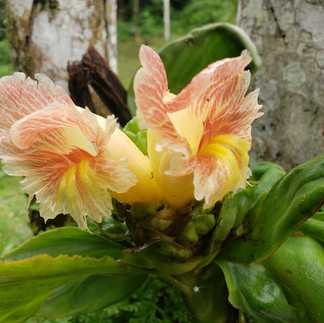













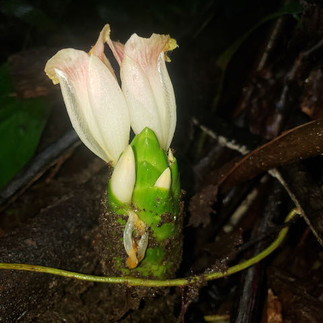



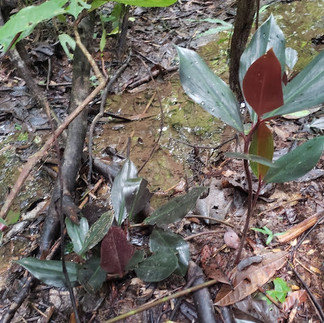

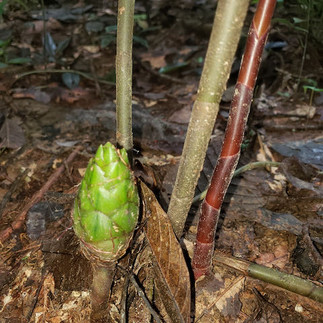












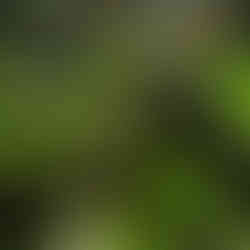





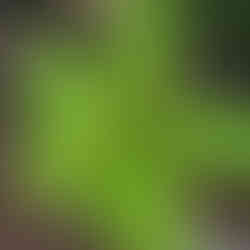





Comments